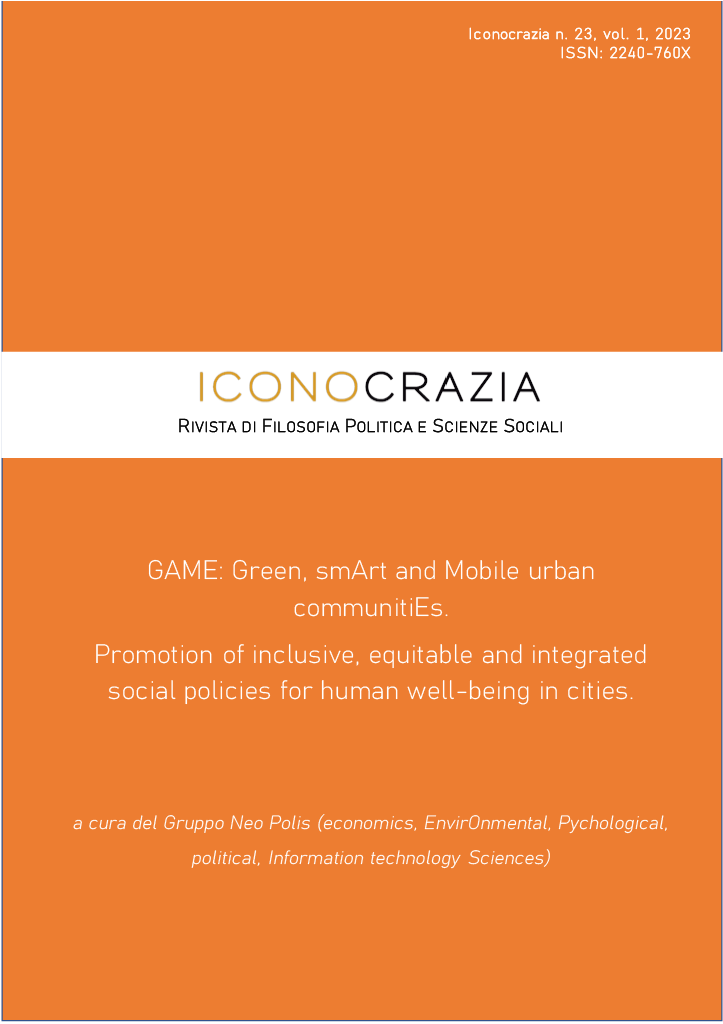La mobilità sostenibile nelle smart city: Prospettive, sfide e soluzioni
DOI:
https://doi.org/10.15162/2240-760X/1847Parole chiave:
Smart city, mobilità sostenibile, smart mobility, sfide urbane, smart city, sustainable mobility, urban challengesAbstract
Le città di tutto il mondo affrontano sfide crescenti in termini di congestione del traffico, inquinamento atmosferico e cambiamenti climatici. La smart mobility è emersa come una risposta cruciale a queste sfide, e le smart city offrono un terreno fertile per l'innovazione in questo settore. Questo studio si propone di esaminare il ruolo della mobilità sostenibile nelle smart city, analizzando prospettive, sfide e soluzioni.
Cities around the world face growing challenges in terms of traffic congestion, air pollution and climate change. Smart mobility has emerged as a crucial response to these challenges, and smart cities offer fertile ground for innovation in this area. This study aims to examine the role of sustainable mobility in smart cities, analysing perspectives, challenges and solutions.
Riferimenti bibliografici
Al Sharif R. (2022). Smart City Dimensions and Associated Risks: Review of literature, Sustainable Cities and Society, 77, pp. 1-14. 10.1016/j.scs.2021.103542.
Aletà N. B., Alonso C. M. e Ruiz R. M. A. (2017). Smart Mobility and Smart Environment in the Spanish cities, Transportation Research Procedia, 24, pp. 163-170.
1016/j.trpro.2017.05.084.
Allam Z. e Newman P. (2018). Redefining the smart city: Culture, metabolism and governance, Smart Cities, 1 (1), pp. 4-25. 10.3390/smartcities1010002.
Baldassarre M. T., Barletta V. S., Caivano D., Raguseo D., Scalera M. (2019). Teaching Cyber Security: The HACK-SPACE Integrated Model, in P. Degano e R. Zunino (a cura di), ITASEC19, Vol. 2315.
Batty M. (2013). Big data, smart cities and city planning, Dialogues Hum Geogr, 3 (3), pp. 274–279.
1177/2043820613513390.
Dobaj J., Macher G., Ekert D., Riel A. e Messnarz R. (2021). Towards a security-driven automotive development lifecycle, Journal of Software: Evolution and Process, SPECIAL ISSUE - METHODOLOGY PAPER, pp. 1-22. 10.1002/smr.2407.
EY e IIA (2021). Move to the future: la mobilità del 2031, EY and IIA.
Garcia M. H. C. et al. (2021). A Tutorial on 5G NR V2X Communications, IEEE Communications Surveys and Tutorials, 23 (3), pp. 1972-2026.
1109/COMST.2021.3057017.
Manyika J., Chui M., Brown B., Bughin J., Dobbs R., Roxburgh C. e Hung Byers A. (2011). Big data: The next frontier for innovation, competition, and productivity, McKinsey Global Institute.
Mayer-Schönberger V., Cukier K. N. (2013). Big Data: A Revolution That Will Transform How We Live, Work, and Think, Boston: Houghton Mifflin Harcourt.
Mir U., Abbasi U., Mir T., Kanwal S. e Alamri S. (2021). Energy Management in Smart Buildings and Homes: Current Approaches, a Hypothetical Solution, and Open Issues and Challenges, IEEE Access, 9, pp. 94132-94148.
1109/ACCESS.2021.3092304.
Olson N. (2016). The Internet of things, New Media Soc, 18 (4), pp. 680-682.
1177/1461444815621893a.
Pham M. e Xiong K. (2021). A survey on security attacks and defense techniques for connected and autonomous vehicles, Computer & Security, 109, pp. 102269-102373.
1016/j.cose.2021.102269.
Rahman M. W., Islam R., Hasan A., Bithi N. I., Hasan M. M. e Rahman M. M. (2022). Intelligent waste management system using deep learning with IoT, Journal of King Saud University - Computer and Information Sciences, 34 (5), pp. 2072-2087.
1016/j.jksuci.2020.08.016.
Smith M., Miller S. (2022). The ethical application of biometric facial recognition technology, AI Soc, 37 (1), pp. 167–175. 10.1007/s00146-021-01199-9.
Sommer F., Dürrwang J. e Kriesten R. (2019). Survey and classification of automotive security attacks, Information, 10 (4), pp. 1-29.
3390/info10040148.
Taylor P. J., Dargahi T., Dehghantanha A., Parizi R. M. e Choo K. K. R. (2020). A systematic literature review of blockchain cyber security, Digital Communications and Networks, 6 (2), pp. 147-156. 10.1016/j.dcan.2019.01.005.
Thaseen Ikram S., Mohanraj V., Ramachandran S. e Balakrishnan A. (2023). An Intelligent Waste Management Application Using IoT and a Genetic Algorithm–Fuzzy Inference System, Applied Sciences (Switzerland), 13 (6).
3390/app13063943.
Uganya G., Rajalakshmi D., Teekaraman Y., Kuppusamy R. e Radhakrishnan A. (2022). A Novel Strategy for Waste Prediction Using Machine Learning Algorithm with IoT Based Intelligent Waste Management System, Wirel Commun Mob Comput, pp. 1-15. 10.1155/2022/2063372.
Umair M., Cheema M. A., Cheema O., Li H., Lu H. (2021). Impact of COVID-19 on iot adoption in healthcare, smart homes, smart buildings, smart cities, transportation and industrial IoT, Sensors, 21 (11), pp. 1-33.
3390/s21113838.
Yaga D., Mell P., Roby N. e Scarfone K. (2018). Blockchain technology overview, Nistir 8202.
6028/NIST.IR.8202.
Yan L., Sheng M., Wang C., Gao R. e Yu H. (2022). Hybrid neural networks based facial expression recognition for smart city, Multimed Tools Appl, 81 (1), pp. 319–342.
1007/s11042-021-11530-7.
Zaheer T., Malik A. W., Rahman A. U., Zahir A. e Fraz M. M. (2019). A vehicular network–based intelligent transport system for smart cities, International Journal of Distributed Sensor Networks, 15 (11), pp. 1-13.
1177/1550147719888845.







